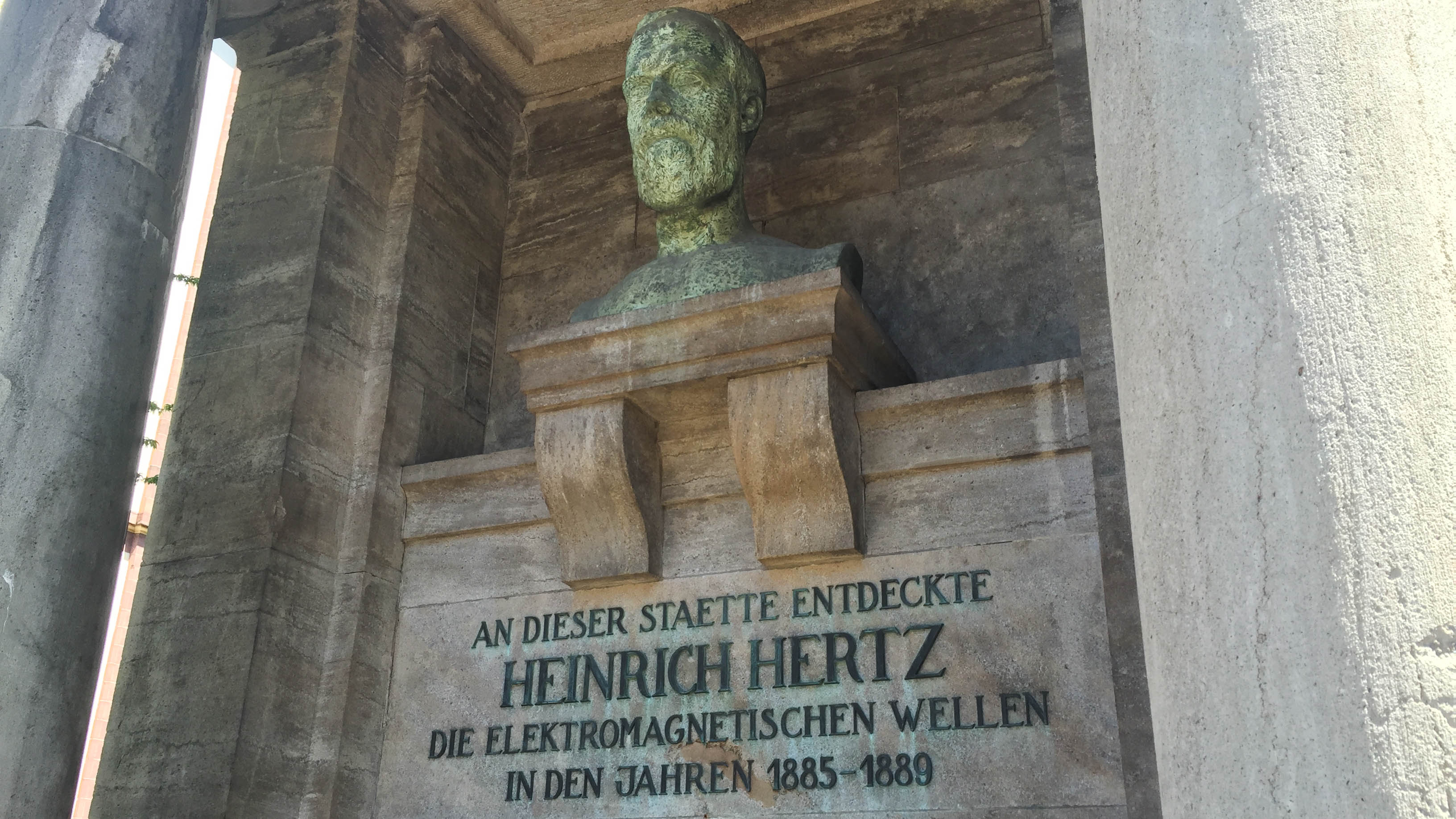The history of Heinrich Hertz and the discovery of radio waves
Listen
The Hertz memorial in Karlsruhe
For those who love science and radio (and who doesn’t), the German city of Karlsruhe should have a special place in their hearts. It was there that physicist Heinrich Hertz proved the existence of radio waves in the 1880s at a university now known as Karlsruhe Institute of Technology.
Karlsruhe also happens to be my hometown, and during a visit in June, I decided to explore the site of Hertz’ famous experiments.
It was a beautiful, but brutally hot, summer day, and I was sweating quite a bit by the time I biked to campus and walked over to the Hertz memorial, a big stone sculpture of the famous physicist’s head.
My “tour guide,” Professor Volker Krebs, wore a white straw hat to protect him against the sun’s rays. Krebs used to teach engineering at this university before retiring, he now heads the Heinrich Hertz Gesellschaft (association) and is helping to keep the scientist’s legacy alive.
Heinrich Hertz came to Karlsruhe in 1885 and used his time here to build on the work of the Scottish physicist James Maxwell.
“Maxwell was the ingenious professor who was able to formulate the laws of propagation of electromagnetic waves in the famous Maxwell equations,” explained Krebs.
One hundred and thirty years ago, everything known about electromagnetic waves was theory, it was all mathematic equations on paper. At the time, there were two competing ideas regarding how quickly these waves traveled. One camp argued that electric and magnetic forces were transmitted immediately from one point to another. According to this theory, if you picked up a magnet and waved it around, that would immediately affect all the other charges in the room, with no time delay.
Maxwell’s theory, on the other hand, predicted that electromagnetic waves propagated through space at the speed of light.
Hertz set out to find out which theory was right – and did so in an old stone building very close to the Hertz memorial, where I met up with Volker Krebs.
It was warm inside, too, and we got a bit winded climbing up a few flights of stairs to a large lecture room. “This is the original laboratory, where Heinrich Hertz did this experiment,” said Krebs, as we entered the sunlit room, now furnished with modern seats and tables.
When Hertz got to Karlsruhe, student enrollment was low, because the economy at the time was struggling. “So he didn’t have many students, and he enjoyed this,” said Krebs. “If you have no students, and you are not immediately interested in teaching, you can have more time for your experiments, and that is a problem of today’s professors sometimes too!”
So, Hertz devoted all of his time and energy to designing a special setup for his experiments. On one side of a long table, he had an oscillator generating electrical currents and a spark or ignition. A few yards away, he set up a receiver or antenna made from copper wire bent into a circle. At the ends of the circle were small knobs separated by a tiny gap. It looks like a big version of the kind of ring people use for piercing their belly button. He wanted to test if the sparks generated by the oscillator would travel to the antenna, and create a spark there, in that tiny gap.
“And when the ignition takes place here, Hertz noticed that in this antenna, here you find ignition, too,” said Krebs. “It’s a hundredth of a millimeter, so you can’t see it very clearly, so he had to darken the room, and then he had a microscope to look at this point and to notice whether there was ignition or not.”
And it worked. The spark generated on the one side propagates an electromagnetic wave, which travels through the room to the antenna, and a quick spark is seen when generated voltage is high enough.
Hertz was the first to detect this spark in the antenna. At the end of 1888, he wrote a famous paper demonstrating that Maxwell was right, electromagnetic waves aren’t infinitely fast, but instead, they travel at the speed of light.
“This paper was called ‘Strahlen elektrischer Kraft,'” said Krebs, which translates to “rays of electrical force.”
And with that, Hertz was pretty much finished with this topic. In what seems inconceivable by today’s standards, he was not interested in what could be done with his discovery. He’s quoted saying that he didn’t think these waves would have any practical applications.
Hertz went on to teach in Bonn, where Krebs said he started working on other issues. “He was interested in mechanics, and that is quite another subject.”
Hertz died in 1894 from an infection. He didn’t live to see the unit of frequency named after him – that happened in 1930 – or to see how his discovery changed every aspect of communication. But, every time we turn on a radio, or talk on our cell phones, we have Hertz to thank.
WHYY is your source for fact-based, in-depth journalism and information. As a nonprofit organization, we rely on financial support from readers like you. Please give today.




